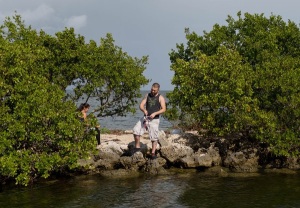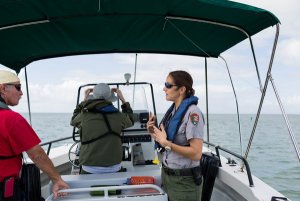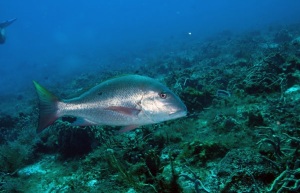By: Lizette Alvarez

Fishing from a jetty this month at Biscayne National Park in Florida. The state opposes federal consideration of a no-fishing zone under a conservation plan. Credit Jason Henry for The New York Times
BISCAYNE NATIONAL PARK, Fla. — For 15 years, officials, environmentalists, fishermen and boaters have struggled to put together a plan to protect one of South Florida’s jewels — a national park, almost entirely underwater, where a part of the largest reef tract in the United States lures throngs of divers and anglers who fish its once-abundant grouper and snapper.
Now, with a plan almost in place to tackle decades of deterioration that has left coral sick and fragile, sea grass stripped clean in places by boats, and the fish population dangerously depleted, one bitter issue remains vexing.
The dispute, on one level, seems simple: Should federal officials ban fishing in 10,522 acres, or 6 percent, of Biscayne National Park, to help replenish the snapper and grouper? Or should they do as the state and the powerful marine industry want and try incremental fixes first, toughening existing rules? Saltwater recreational fishing pumps $7.6 billion a year into Florida’s economy, the largest total in the country.
Bubbling over the disagreement, however, is a larger question of fairness and consistency in park policies, federal park officials said. Strict rules designed to protect resources and ecosystems in the most cherished national parks — no hunting in Yosemite, for example — seem to get short shrift when applied to the fish and coral reefs here in the country’s largest marine park, they said.
“Biscayne is a national park,” said Brian Carlstrom, the park’s new superintendent. “If this were national park land” — as opposed to national park water — “there would be no question of what resources can be extracted from here.”
Mr. Carlstrom said the habitat across the 173,000 acres of the park, just off the shore of metropolitan Miami, had visibly deteriorated in the past 15 years, which is why officials have been developing a new general management plan.
“If you go out there right now, you won’t see the large predatory fish, because they are not out there,” he said. “Once they reach the legal size limit, they get caught and harvested at that point in time.”
The fish have come under pressure not only from South Florida’s booming population but also because fast boats, GPS devices and other high-powered gear make finding and catching fish much easier than it was a couple of decades back. Increasingly, though, anglers return with nothing but grunts, which were once considered to be “reject” fish, park officials said.
Closing the 10,522 acres to fishing — a section of the park that the federal government controls alone — is one of several options on the table, Mr. Carlstrom said. It has been shown, in some cases, to be an effective and quick way to replenish fish stocks, scientists said. The larger that a fish is allowed to grow, the more eggs that are released. In Dry Tortugas National Park, off Key West, this approach has helped fish rebound not just in the reserve but also beyond it, the scientists added.
A “no-take” zone, Mr. Carlstrom said, would also simplify layers of complex fishing rules for overtaxed marine patrols and anglers who have trouble keeping track of ever-changing regulations. No fishing, he said, simply means no fishing.
“Biscayne is one of the most valuable parks in the system, including Yellowstone, because of what it is and where it is,” said Jerald S. Ault, a professor of marine biology and fisheries at the University of Miami who has studied the success of the Dry Tortugas reserve. “It’s a little bit,” he added, like the Dutch boy’s “putting his finger in the dike, but the park is trying to set the standard.”

Gil Muratori, a fisherman who supports a ban, on the water with Vanessa McDonough, right, a park biologist. Credit Jason Henry for The New York Times
State officials bristle at the idea of a no-take reserve. They said the proposed section is one of the park’s most popular areas and covers about 30 percent of the reef tract. In their view, shutting down fishing should always be a last resort, and in this case it is not, they argued.
“There are lots of other fishery management tools out there that need to be tried first,” said Jessica McCawley, the director of the marine fisheries management division for the Florida Fish and Wildlife Conservation Commission. “Once you have to close down an area, it’s almost like fisheries management has failed.”
Agency officials added that they wanted firmer science behind the no-take alternative and better estimates of the fish population in the 10,522 acres.
“Some of the data we don’t necessarily agree with,” Ms. McCawley said. “I’m not saying that overall fishery resources are in as good a shape as they were 20 years ago,” but the state commission and the National Park Service disagree on the extent of the decline, she added.
Many recreational anglers and the industries that support them agree with the agency’s position. Nobody wants to see the fish vanish altogether, but reaching for the most extreme solution does not make sense, they said.
“This would take 30 percent of the best reef fishing away from the fisherman,” said Carl Liederman, the president of Captain Harry’s Fishing Supply in Miami and a member of several fishermen’s and conservation groups. “Let’s see if we can fix it before we close 10,000 acres in one of the largest boating areas in the country.” He added that he always finds grouper in the park to catch.
The state and federal governments are not completely at odds; each understands that fish do not recognize artificial boundaries. In July, the two agencies completed a separate fishery management plan that set goals for the entire park. (The federal government solely controls only two-thirds of the park.) They agreed to increase the fish population by 20 percent, create tougher restrictions on spearfishing gear, phase out commercial fishing and end a two-day lobster season for recreational users. Now state regulators must figure out how to put the goals into effect.
The larger question of the no-take reserve, though, still poses a hurdle for overall management. Gil Muratori, who is part of a coalition of recreational fishermen pushing to ban fishing, said anglers, including himself, are to blame for the situation. For decades, Mr. Muratori said, they have needlessly packed coolers with too many fish.
The park should be treated with the respect it deserves, he said.
“Everyone feels that, as an American citizen, they can fish wherever they want, but people accept that you can’t shoot buffalo or deer at Yellowstone and Yosemite,” Mr. Muratori said. “There is a lack of understanding, in my opinion. What people accept on land they have a problem accepting on water.”

